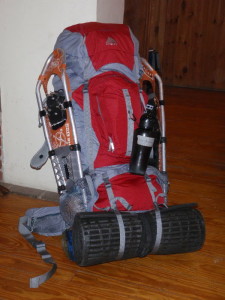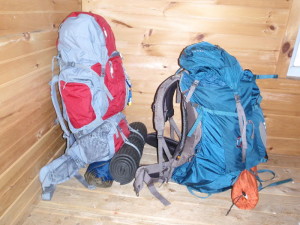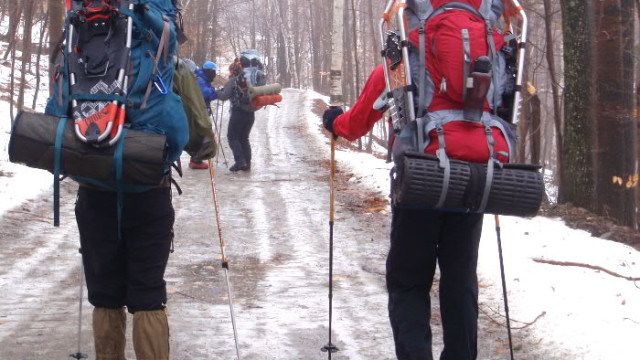
Go to any major outdoor retailer’s site, and check out the “extended trip” packs. 65 liters…80 liters…maybe even 90 liters. Those are big packs, designed to allow you to go out for a week, hike the Appalachian Trail, fun stuff like that. But up in the rarefied atmosphere at the very top of the hill are a few packs that are over 100 liters. These are “monster backpacks”…capable of carrying weights that sane people wouldn’t consider. Why in the world would anyone want one of these behemoths, anyway???
Well, three reasons. The first is a situation where you need to carry someone else’s stuff. That might be a trip with the kids, an aging parent, a much smaller spouse, or someone who has no experience backpacking and you don’t want to scare them with a heavy pack the first time out. The second is carrying large loads in to a remote cabin or camp for a relatively short distance; it’s a great way to stock the pantry! And the third, near and dear to our hearts, is winter camping. Simply put, there’s a LOT of bulk involved. Sleeping bag, two sleeping pads, thick fleece camp clothes; a smaller pack just doesn’t cut it in winter. You CAN do it…but a monster pack makes it a lot easier!
The problem, though, is that monster packs are typically very expensive…again, for three reasons. They’re bigger…more material, more straps and buckles, more pockets, more hand labor to build them. They need to be designed to handle heavy loads…with all that room, you can stuff lots of heavy items inside, so stitching has to be reinforced, hipbelts need to be thicker and sturdier, etc. And, they sell a lot fewer of them, so the economy of scale is off the chart. Most packs of this size will run in the $400-500 range; the Osprey Argon 110 being right in there at $419. That’s a big hit on your wallet…and is it worth it? And are there any options?
Turns out that there IS one option…the Kelty Red Cloud 6650. That’s 6650, as in cubic inches…or 108 liters. A true monster, its suggested retail price is half what the others in the category are…$210. That’s getting down into the price range of some of the daypacks you can buy. Can it really be any good? Kelty’s long been a favorite of mine…I still own two of their tents, and had one of their external frame packs for years (still have it for people to borrow, actually!). They’ve always been high value for the dollar, so…maybe it WILL be a good pack. Ah…product testing…we love it!

Luckily, it’s winter, and we had a trip planned to the Merck Forest, so the timing was perfect to put it through its paces, side-by-side with the Osprey. Long-time readers will probably know that the Argon 110 is on our “Favorite Things” list. I’ve carried over 90 pounds in it up to the Black Mountain Cabin with no discomfort, other than very tired legs. The suspension system is incredible; I don’t have much for hips, which makes holding a backpack up on them a challenge, but that belt snugs in over them beautifully. The design of the pack allows the weight to be carried very close to the back, following the curve of the spine…so the load doesn’t tend to shift and throw you off balance when you duck sideways to avoid an overhanging branch. There’s a strap for everything; you can attach ice axes, snowshoes, cross country skis, whatever your heart desires. The strap arrangement also does an excellent job of shrinking the pack if you’re carrying a more “normal” load…so, this is a great pack not just for monster trips, but also for general overnight use. Flaws? Some of the ways that the straps work are counterintuitive and asymmetrical, leading to a certain amount of headscratching as you try to figure out the best way to stow & attach items. If that’s the worst thing I can find to say about a pack, it’s clearly a great product!
But…for half the price…is the Kelty a giant killer? Out of the box, it’s an impressive looking beast. It’s got the de rigeur features you’d expect in a high-end pack…hydration pouch, top lid that converts to a lumbar pack, sleeping bag compartment, compression straps all over, loops for lashing things to. All those compression straps also allow for shrinking the pack, so it’ll be useful for more “normal” use, too. It’s got quite the array of pockets as well; it would probably take as long to figure out the best use for all of them as it does to figure out the straps on the Osprey. One very neat feature is that one of the loops on the back of the pack doubles as a carry handle; big packs don’t usually carry well as suitcases, but this one does! And then there’s the suspension. Kelty calls it the “Cloudlock 2”, and I have no idea why…but it works. It is, hands down, the easiest to adjust to torso length that I’ve ever seen. Turn the pack on its back, grab the strap in the center, loosen the Velcro, slide it up or down the appropriate amount, secure the Velcro…you’re done. Impressive!
The rest of the suspension comes in with another “impressive”…but also with the caveat “for the price.” The hip belt is definitely not in the same league as the Osprey’s. But it kicks the daylights out of my old Mountainsmith; fits snugly around my waist, supports the load on my hips well. The shaping of the belt isn’t the same as the Argon’s, though, and I had to tighten the waist belt more to get it to stay put. It wasn’t uncomfortable, not by a long shot…but not as comfortable as the Argon’s. Still with the pack loaded to 85 plus pounds, it felt solid and planted on my hips; that’s something I definitely wouldn’t have felt with my Mountainsmith.

On the trail, the differences between the packs became more obvious. The Kelty is a tall, narrow pack; the Osprey, shorter and deeper. That forces more of the load in the Kelty to be carried high up over the shoulders. There’s another concern about that shape, as well; if your winter sleeping bag has a compression stuff sack that makes it short and fat, it can be difficult to get into the sleeping bag compartment. However, given the price of the pack, if THAT’S the only problem, another stuff sack of a different shape is a cheap solution! Not surprisingly, given the different shape, the incredible stability with heavy loads that the Argon 110 has just isn’t there in the same way with the Red Cloud 6650. In order to fully stabilize the load, I had to tighten the shoulder straps down a bit more, sacrificing a little comfort. And I do mean a little comfort; even with a ridiculous load in it, the comfort was greater than with any huge pack other than the Osprey that I’ve used. Two hours of climbing with it, and I still felt fresh and ready for more. Clearly, this is a true monster pack; it’s not only big, but it’s designed from the ground up to carry monster loads. One feature of the Kelty that was beyond the scope of this test is the “Lightbeam II” aluminum frame stays, which can be bent and adjusted to fit your personal body shape. With two of us trading packs back and forth, that just wasn’t practical, but it will be something we’ll test out in the future, as it might improve the load stability. Expect an update this summer!
So…which should you buy? Hands down, the Osprey Argon 110 won this comparison test. The comfort and stability under heavy loads is just plain beyond what the Kelty can pull off. On the other hand, at less than half the price, the Kelty Red Cloud 6650 can do virtually everything the Osprey can do, and surprisingly well. Our opinion: If money is no object, buy the Osprey. If you do a lot of heavy duty backpacking where you are carrying major loads, buy the Osprey. But if you’re on a budget, buy the Kelty. If you want to try winter backpacking for the first time, buy the Kelty and put the difference in price into a good sleeping bag. Either pack will do the job of carrying huge loads; either pack will allow you to take on challenges that smaller packs won’t. Choose one of them, fill it with appropriate winter backpacking gear, and get out there!



[…] friends over at EasternSlopes publish articles covering a range of snow sports. Recently David Shedd published a review of two monster packs: Osprey Argon 110 & Kelty Red Cloud 6650 suitable for winter […]
Dave – Great review. Even for a hardcore backpacker (which I am not), it has to be hard paying double when the less expensive Kelty can do everything just as well. Are there any other 100+ liter packs in the $200 or less price range, or is Kelty really all by itself?
Great article, after 25 years I’ve returned to winter camping backpacking & hiking
Okay pls tell me what kind of stiff hiking boots are good enuff for serious frontpointing up moderate trails in the White mountains in winter.
I’ve tried some ” hiking boots” that are glorified rubber muckluks with various trendy soles and brands none which are stuff enuff for serious mountain hiking even in Summer.
I wld love to stay under $300- $400 max
Dav, While most mountaineers these days gravitate toward the double-layer plastic shell boots, we’ve had good luck with lighter stiff-soled single boots. Take a look at the Lowa Mountain Expert and similar boots from La Sportive, Garmont, Asolo, Koflach and others. Remember, fit is critical.
I read the Lowa review very informative.
My needs require full crampons.
Koflach back in the day was very unforgiving as that innerboot didn’t mesh well with the hard outer boot.
I’m looking for something I can do Lion head in winter or long winter camping or summer big trees.
Thx